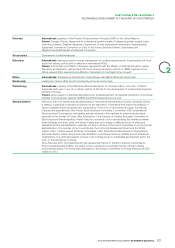APC 2015 Annual Report Download - page 65
Download and view the complete annual report
Please find page 65 of the 2015 APC annual report below. You can navigate through the pages in the report by either clicking on the pages listed below, or by using the keyword search tool below to find specific information within the annual report.
2015 REGISTRATION DOCUMENT SCHNEIDER ELECTRIC 63
SUSTAINABLE DEVELOPMENT
2
GREEN AND RESPONSIBLE GROWTH DRIVING ECONOMIC PERFORMANCE
2.3 Relations with subcontractors andsuppliers
Approach
As a Global Compact signatory, Schneider Electric has been
involved in an ambitious approach to include sustainable
development challenges in the supplier selection and working
processes. This approach is all the more important as Schneider
Electric’s purchasing volume represents more than EUR12billion.
Schneider Electric has published a charter for its suppliers,
called the Supplier Guide Book, which includes a large section
on expectations with regards to sustainable development in the
following four areas: health and safety, human rights, ethics and
the environment.
Since 2004, the Group has been encouraging its suppliers to
commit to a sustainable development process. A key performance
indicator was defi ned in the Planet & Society barometer for the
duration of the 2009-2011 One program: at the end of2011, more
than 50% of Schneider Electric purchases were from suppliers who
had signed the 10 principles of the Global Compact or the EICC
(Electronic Industry Citizenship Coalition). Since 2012, Schneider
Electric has wanted to place itself in a continuous improvement
process as well as follow-up with its suppliers by encouraging them
to make progress according to the ISO26000 guidelines.
This approach is strengthened by the General Purchasing Terms
and Conditions to which all suppliers must conform: each supplier
undertakes to adhere to and to apply the principles and guidelines
of the ISO 26000 international standard, the rules defi ned in the
ISO14001 standard, and is informed that energy performance of its
supply has been considered as part of the selection criteria. Suppliers
also commit to respect all national legislation and regulations, the
REACH regulation and the RoHS directives, and, more generally,
the laws and regulations relating to prohibition or restriction of use
of certain products or substances. Lastly, suppliers are expected
to report the presence and country of origin of any and all confl ict
minerals supplies in accordance with the requirements of the US
Dodd-Frank Act of 2010 known as the «Confl ict Minerals » law.
In this context, Schneider Electric has a «confl ict-free» objective.
Action plans
Integration of the sustainable purchases approach in
the selection of new suppliers
Schneider Electric uses a qualifi cation process called Schneider
Supplier Quality Management to select new suppliers. It is based
on an evaluation questionnaire combined with on-site audits by
Schneider Electric quality specialists.
It includes a specifi c section on the environment and sustainable
development and aims to assess supplier suitability with regard to
the Group’s expectations in three areas:
•social responsibility: ISO 26000 guidelines and, in particular,
Confl ict Minerals regulations;
•environment: ISO14001, ISO14062 on eco-design, REACH and
RoHS;
•safety: health, safety standards, accidents and severity rate.
Sustainable development criteria account for nearly 15% of supplier
evaluation. In addition, all these criteria have a minimum level, below
which a supplier will not be retained to work with Schneider Electric.
Schneider Electric carried out 550 audits of this type in2015. In
2014, the Group launched an e-learning program which covers
expectations in these fi elds and defi nes the documents and proof
to be obtained from audited suppliers.
This qualifi cation process applies to all new suppliers and to existing
suppliers in certain cases. All assessed suppliers have an action
plan, registered in our central database. These are tracked by our
supplier leaders with the suppliers on a monthly or pluri-annual
basis depending on the severity of the action plan.
Promotion of a continuous improvement process
based on the ISO26000 standard
A statement on the importance of sustainable development is
made to each major supplier of Schneider Electric by its Group
purchasing pilot after the latter has been trained in the approach.
For these suppliers, in2012 Schneider Electric began an initiative
that is based on an evaluation carried out by a third party.
Sustainable development has become one of the sevenpillars used
to measure supplier performance since2011; allowing the highest-
performing suppliers to become «recommended» suppliers. The
performance resulting from the third party evaluation is one of the
key points of the sustainable development pillar. In 2015-2017, the
Group aimes to engage 100% of its recommended suppliers in a
process of continuous improvement on this pillar. Recommended
suppliers represent 56% of Schneider Electric’s purchases volume.
At the end of 2015, 64.7% of the recommended suppliers have
passed the third-party evaluation process, representing over 80%
of the purchasing volume of these suppliers. This indicator of the
Planet & Society barometer is integrated into the performance
incentive of the Purchasing employees receiving a bonus.
This assessment process requires that the suppliers put in place a
corrective action plan. The elements of the assessment are now an
integral part of the business reviews scheduled between buyers and
suppliers, on a quarterly to yearly basis, depending on the suppliers.
This monitoring supposes an improvement from the supplier.
























